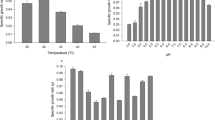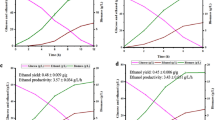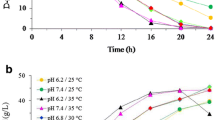Summary
The ability ofCandida guillermondii to produce xylitol from xylose and to ferment individual non xylose hemicellulosic derived sugars was investigated in microaerobic conditions. Xylose was converted into xylitol with a yield of 0,63 g/g and ethanol was produced in negligible amounts. The strain did not convert glucose, mannose and galactose into their corresponding polyols but only into ethanol and cell mass. By contrast, fermentation of arabinose lead to the formation of arabitol. On D-xylose medium,Candida guillermondii exhibited high yield and rate of xylitol production when the initial sugar concentration exceeded 110 g/l. A final xylitol concentration of 221 g/l was obtained from 300 g/l D-xylose with a yield of 82,6% of theoretical and an average specific rate of 0,19 g/g.h.
Similar content being viewed by others
Abbreviations
- Qp :
-
average volumetric productivity of xylitol (g xylitol/l per hour)
- qp :
-
average specific productivity of xylitol (g xylitol/g of cells per hour)
- So:
-
initial xylose concentration (g/l)
- tf:
-
incubation time (hours)
- YP/S :
-
xylitol yield (g of xylitol produced/g of xylose utilized)
- YE/S :
-
ethanol yield (g of ethanol produced/g of substrate utilized)
- YX/S :
-
cells yield (g of cells/g of substrate utilized)
- μ:
-
specific growth rate coefficient (h−1)
- μmax :
-
maximum specific growth rate coefficient (h−1)
Bibliography
Barbosa, M.F.S., De Meideiros M.B., De Mancilha I.M., Schneider H. and Lee H. (1988). J. of Indust. Microbiol, 3, 241–251.
Bolen P.L. and Detroy R.W. (1985). Biotechnol. Bioeng., 27, 302–307.
Chen L.F. and Gong C.S. (1985). J. Food Sci, 50, 226–228.
Gong C.S., Chen L.F., Tsao G.T. (1981), Biotechnol. Lett, 3(3), 130–135.
Hyvönen L. and Koivistoinen P. (1983). Adv. in Food Research, 28, 373–403.
Melaja A. and Hämälaïnen L. (1977). Process for making xylitol. US Patent 4,008,285.
Onishi H. and Suzuki T. (1966). Agric. Biol. Chem., 30, 1139–1144.
Pepper T. and Olinger P.M. (1988). Food Technol, 10, 98–106.
Prior B.A., Kilian S.G., Du Preez J.C. (1989). Process Biochem, 24(1), 21–32.
Suzuki T. and Onishi H. (1975). Agric. Biol. Chem., 39, 2389.
Vongsuvanlert V. and Tani Y. (1989). J. Ferment and Bioeng, 67(1), 35–39.
Wang S.Y.C. and Letourneau D. (1973). Arch. Microbiol., 93, 87–90.
Wickerham L.J. (1951). Taxonomy of yeasts. Techn. Bull. no 1029, US Dept of Agric., Washington DC.
Ylikahri R. (1979). Adv. in Food Res., 25, 159–180.
Author information
Authors and Affiliations
Rights and permissions
About this article
Cite this article
Meyrial, V., Delgenes, J.P., Moletta, R. et al. Xylitol production from D-xylose byCandida guillermondii: Fermentation behaviour. Biotechnol Lett 13, 281–286 (1991). https://doi.org/10.1007/BF01041485
Issue Date:
DOI: https://doi.org/10.1007/BF01041485




